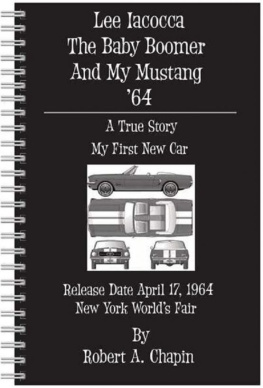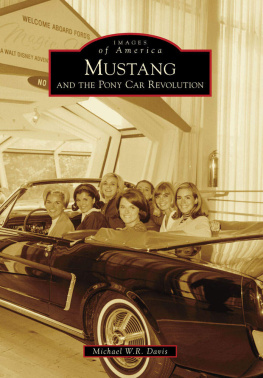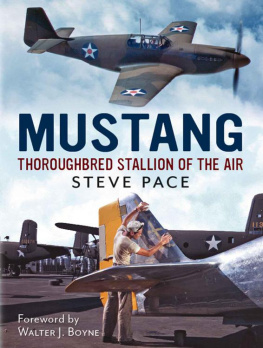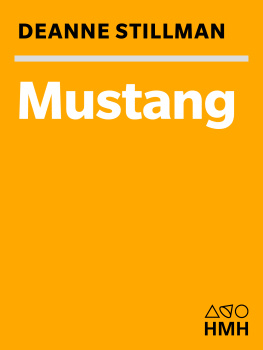SPEED READ
MUSTANG
THE HISTORY, DESIGN AND CULTURE BEHIND FORDS ORIGINAL PONY CAR
DONALD FARR

INTRODUCTION
Standing at a podium within the Ford Pavilion at the New York Worlds Fair, Lee Iacocca spoke like a proud father as he introduced the new Ford Mustang to the worlds press reporters on April 13, 1964. We think people will want the Mustang because it offers them a different kind of car at low cost, Iacocca said, because it satisfies their need for basic transportation and their desire for comfort, fresh style, good handling, and a choice of performance capabilities. This is the car we have designed with young America in mind.
For Iacocca, everything was on the linehis reputation, his legacy, even his career. Ford Motor Company CEO Henry Ford II, still reeling from the Edsel failure, had made it clear when he approved the budget to develop Iacoccas new model: Youve got to sell it, and its your ass if you dont!
In hindsight, we now know that Iacoccas joband successful futurewas safe. Bolstered by a creative (and expensive) marketing campaign, Ford dealers sold 22,000 Mustangs during the first on-sale weekend, over 120,000 by the end of summer 1964, and more than 680,000 before the 1965 model year ended. Sales topped 1 million by February 1966, making the Mustang the most successful vehicle launch in American automotive history.
Although based on the Falcon, the Mustangs combination of sporty styling, low cost, long list of options, and practicality as a four-seater with a trunk transformed Fords economy compact into a trendsetter, one that spawned an entirely new Pony Car segmentnamed after the Mustang, of course. Soon, the American highways were filled with Mustangs, Camaros, Cougars, Firebirds, Barracudas, and Challengers.
But unlike its upstart competitors, Mustang production has continued uninterrupted for over fifty-three years, something no other American vehicle nameplate can claimnot even the Corvette, which was introduced eleven years before the Mustang but skipped the 1983 model year entirely.
For millions of owners worldwide, the Mustang is more than a car. Its also a lifestyle, one supported by clubs, parts manufacturers and suppliers, magazines and websites, and specific model registries. The Mustang Club of America alone boasts over one hundred regional clubs, not only in the United States but also worldwide in countries like France, Italy, Taiwan, and Brazil. These enthusiast organizations host thousands of shows, cruises, races, and rallies each year, bringing owners together to celebrate their common allegiance to the Mustang. Few other brands, automotive or otherwise, can claim that kind of loyalty and devotion.
Over the years, popular models like Mach 1, Boss, Grande, and Shelby have expanded the Mustangs reach. The Mustang has become so ingrained in American culture that it was selected in 1999 for a US Post Office Celebrate the Century stamp alongside the Woodstock Music Festival and man walking on the moon. Mustangs have appeared in over five hundred movies, including starring roles in Gone in 60 Seconds and Bullitt, featuring actor Steve McQueen and a Highland Green fastback that inspired special Bullitt-edition Mustangs from Ford. The Mustangs free-wheeling and fun attitude has made it a popular subject for songs, topped by Wilson Picketts Mustang Sally, to this day a popular sing-along tune for dance band and DJ audiences.
Over half a decade since Iacocca stood at that Worlds Fair podium, the Mustang is still going strong. It has survived pony car competition, two major fuel crises, economic downturns, and even an unsuccessful effort by some within Ford to abandon the traditional rear-wheel-drive for a radical switch to front-wheel-drive based on a Japanese chassis. Through it all, the Mustang has remained true to its original objective as conceived by Iacocca and his team in the early 1960sfun transportation with style, comfort, good handling, performance, and practicality.
THE LAUNCH
THE LAUNCH
LEE IACOCCA
The son of Italian immigrants, Lee Iacocca went to work for Ford in 1946, starting with a sales job at a Pennsylvania assembly plant. But he had a much bigger career goalhe planned to reach company vice president by the age of 35.
Iacocca strategically worked his way up the ladder, moving into a sales manager position for the East Coast, then assistant district manager. His clever $56-a-month for a 56 Ford marketing program led to a promotion and relocation to Dearborn to manage Fords truck marketing, resulting in record truck sales and yet another promotion into car marketing. In November 1960, Henry Ford II promoted Iacocca to vice president and general manager of Ford Division. Iacocca was 36.
As the top manager of Ford, Iacocca had the horsepower to pursue a hunch, shared by others at Ford, that a new vehicle would appeal to the Baby Boomer generation as they came of age in the mid-1960s. And he knew very well that Chevrolet was selling more of its Corvair, originally an economy car, by offering a sportier Monza model with bucket seats, stick shift, and upgraded interior trim. There was nothing like it in the Ford lineup.
Iacocca realized that economy-based Falcons and boxy Fairlanes werent the answer. He predicted that, as Baby Boomers matured and reached driving age during the 1960s, the huge youth market would crave sports-car styling and performance combined with the practicality of four seats and a usable trunk. Selling the concept to company President Henry Ford II, who was still reeling from 195860 Edsel failure, would be the challenge.
To convince the man whose name was on the building, Iacocca needed a team to help him gather conclusive data. And they had to do it without anyone finding out.
KEY PERSON
Ford product planning manager Don Frey was among the first at Ford to acknowledge the coming-of-age Baby Boomer generation as a future market opportunity. I realized we were sitting on a powder keg, he said.
BY THE NUMBERS
79 million: Number of births in the United States between 1946 and 1964
FUN FACT
In 1962, Ford debuted a two-seater sports car concept to showcase futuristic ideas like mid-engine design, aerodynamic aluminum body, four-wheel independent suspension, and rack-and-pinion steering. Those components would eventually find their way into future Fords. So would the nameMustang.
THE LAUNCH
FAIRLANE COMMITTEE
To convince Henry Ford II that Ford needed a new car for the upcoming Baby Boomer generation, Lee Iacocca pulled together a hand-selected think tank of Ford managers representing engineering, styling, product planning, market research, racing, public relations, and advertising. Iacocca would lead the group, which would initially meet twice a month in an attempt to identify a market that could lead to a concept for a new vehicle. To avoid alerting Henry Ford II, the first meetings were held in a private conference room at the Fairlane Inn, a hotel on Michigan Avenue in Dearborn. The clandestine group became known as the Fairlane Committee.










